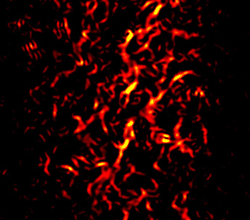Living on the Edge
Computer disk drives need to detect the tiny magnetic fields in which they encode ones and zeros. The “read head” detects these fields because they change its electrical resistance. With improved sensitivity to fields, higher capacity drives might be possible. In the 22 April PRL, a team reports significantly lowering the magnetic field needed to dramatically change the resistance of a material that has so far been impractical for devices. The new detection scheme is based on so-called colossal magnetoresistance (CMR), which generates a much greater change in resistance than today’s read heads do. Even if CMR never makes it into disk drives, researchers hope the effect could be used in new types of technology.
The manganese-based materials that show CMR can exist in both a state of high electrical resistance and a state of low resistance. Chill a chunk of the stuff to the right temperature, and you get a mixture, a set of interspersed regions of each type. In the low-resistance regions, manganese atoms are aligned like rows of bar magnets; electrons line up their spins with these atoms and find it easier to move between neighboring atoms. In the high-resistance regions, the atoms’ so-called magnetic moments point in all directions. Overall, the material’s resistance is high. But a magnetic field can align some of the randomly-oriented atoms and convert them to the low-resistance state, enlarging the low-resistance regions. With a strong enough field, they form a connected path across the whole sample, and the resistance drops more than a thousand-fold. This resistance drop is called the CMR effect.
Last year Masashi Tokunaga and his colleagues from the University of Tokyo studied single crystals of one of these materials [1]. Cooling can have the same effect as a magnetic field, and at 77 degrees Kelvin enough of the manganese atoms align spontaneously to form a continuous path across the sample, even without a magnetic field. Heating reverses this alignment, shrinking the low-resistance regions. Tokunaga and his colleagues found that running a large pulse of electric current through their sample heated the tiny filaments where the current flows and pushed the sample into the high-resistance state. In their latest work, they show that at a lower current level, they could delicately balance the sample at a precipice between low- and high-resistance. If the current was just above a threshold, a magnetic field as low as about a tenth of a tesla nudged the sample back into the low resistance state. This field is much lower than the several tesla required in the absence of the current.
Although the researchers have made the CMR effect sensitive to a smaller magnetic field, many barriers remain to practical use. Most importantly, physicists have only found CMR effects far below room temperature. In contrast, the “giant” magnetoresistance (GMR) effect used in modern disk drives persists well above room temperature, although it involves resistance changes of only tens of percent. GMR is not a material property, but instead is based on engineering a series of thin layers whose resistance depends on the direction of a magnetic field.
Keun Hyuk Ahn of Argonne National Labs says that the reduced magnetic field is important, although disk drives may need even lower fields as well as higher temperatures. But researchers may be able to make other uses of the exotic two-state condition that naturally occurs in CMR materials, says Ahn. They might develop new devices by guiding the spatial patterns that the two states form, according to others in the field.
–Don Monroe
Don Monroe is a freelance science writer in Murray Hill, New Jersey.
References
- M. Tokunaga, Y. Tokunaga, and T. Tamegai, Phys. Rev. Lett. 93, 037203 (2004)
More Information
Physics Today article from 2003 on Colossal magnetoresistance (requires subscription)



